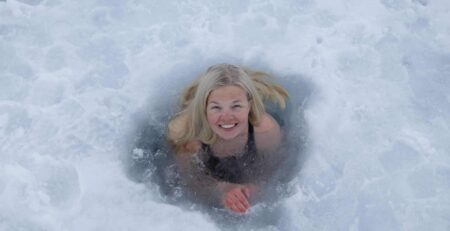You just crushed a workout. Your muscles are on fire, your shirt’s glued to your back, and even tying your shoes feels like a chore. You know what’s coming tomorrow morning: the deep, familiar ache of Delayed Onset Muscle Soreness (DOMS). And then, someone says, “It’s time for a cold plunge.” You look at that tub of freezing water and question your life choices. Still, you’ll find that everyone from professional athletes to weekend warriors swears by this ritual.
It really sounds cruel when you inflict a new kind of stress on tissues that are already stressed. But here’s the twist: there’s real science behind why that self-inflicted torture not only numbs the pain, but it also orchestrates a sophisticated biological recovery process that speeds healing from the inside out.
Table of Contents
The Great Flush: How Cold Water Pumps Your Muscles Clean
The most immediate and mechanical effect most people notice is on their circulatory system. Intense exercise creates microscopic damage to your muscle fibers. This damage triggers a local inflammatory response, where your body sends extra blood and immune cells to the area to start cleaning up and rebuilding. While necessary, this process also causes the swelling, stiffness, and pain we know as soreness.
When you submerge yourself in cold water, something powerful called vasoconstriction happens. Your body, in an effort to preserve core heat, drastically narrows the blood vessels in your extremities and muscles. Think of vasoconstriction like turning down the faucet so the pipes don’t burst.
When you step out and begin to warm up, the opposite occurs, and your blood vessels reopen, often wider than before (vasodilation). This creates a powerful “pumping” action, flushing out the metabolic waste products that have accumulated in the muscles (like lactate) and ushering in a fresh, oxygen-rich supply of blood loaded with nutrients necessary for repair. It’s not about stopping inflammation entirely, but about controlling the flood and ensuring a more efficient cleanup and rebuild cycle. This is relatable to when you press the “refresh” button on your circulatory system.
Dialing Down the Inflammatory Fire
Besides damaged muscle fibers, soreness also leads to the inflammation modulation effect. Your body releases chemical signals called pro-inflammatory cytokines that call in the repair crew. However, these cytokines also cause swelling and pain.
Taking a cold plunge helps calm the storm, acting as a natural anti-inflammatory. The controlled cold stress triggers your body to systemically release anti-inflammatory cytokines. It’s like sending a “stand down” order to your body’s overzealous inflammatory response. Research, particularly in athletic populations, has consistently shown that cold water immersion after exercise significantly reduces markers such as Creatine Kinase (CK) and C-reactive protein (CRP) – both linked to muscle damage and inflammation. As physiologist Dr. Jonathan Peake explains, you’re not blocking the healing process with cold water; you’re creating a calmer, more controlled environment for it to occur, which directly translates to less perceived soreness and faster functional recovery.
Resetting the Nervous System: Quieting the Noise
Have you ever noticed how your whole body seems to “exhale” after a few seconds in the cold? That’s your nervous system stuck in high gear. There’s a neurological component to muscle recovery, where after intense exertion, your nervous system can remain in a heightened state, and the pain signals from the damaged muscles keep firing. This explains why you tend to feel constant, low-grade ache and tightness.
The intense cold provides a phenomenon known as “cold-induced neuropraxia.” This means that the cold temporarily slows down the conduction of nerve signals. But no need to worry too much because it’s not a dangerous numbing. It’s a benevolent quieting. It effectively turns down the volume on the pain signals coming from your muscles, providing immediate relief from soreness and breaking the cycle of pain and tension. This allows for better relaxation and range of motion, which is a very critical part of the recovery process.
The Hormonal Boost
There’s an amazing bonus that a cold plunge gives you when you immerse yourself in cold water. Beyond helping your muscles, cold plunging triggers a hormonal response. The acute stress causes a significant release of norepinephrine. This hormone not only helps with focus and alertness, but it also plays a part in modulating pain perception and enhancing mood. Coupled with the subsequent release of endorphins—the body’s natural painkillers—the post-plunge state is one of reduced discomfort and a sense of well-being, making the overall recovery process feel less grueling.
The Nuance: Timing Matters
There’s one important caveat: Some research suggests jumping into your ice bath tub immediately after strength training might slightly blunt the “muscle-building” signal (mTOR pathway) by reducing inflammation too effectively. But that doesn’t mean you should skip cold plunges. It only requires you to be prepared and strategic. Many athletes now time their plunges strategically, using them after intense endurance or metabolic conditioning sessions where the primary goal is rapid reduction of soreness. For heavy strength lifting sessions, wait a few hours before plunging, so your body has time to kickstart muscle-building.
Conclusion
In the end, the cold plunge is not a punishment. It’s precision muscle recovery, a powerful tool of physiological engineering. It’s a way to manually guide your body through the repair process: reducing the swelling, flushing the waste, quieting the pain, and creating the ideal internal environment for your muscles to rebuild, stronger than before. If you want to discover more effects of immersing yourself in 10–15°C for 10-15 minutes, we have also written an extensive guide on the benefits of the cold plunge.
Further Reading and Resources
- A Foundational Review: “The Effect of Cold Water Immersion on Recovery from Exercise-Induced Muscle Damage” – This meta-analysis consolidates the evidence showing how CWI is an effective recovery tool for reducing soreness and inflammation.
- The Timing Debate: “Post-exercise Cold Water Immersion: Does It Actually Help?” – Articles like this one from Strength and Conditioning Journal delve into the nuances of when and for whom ice baths are most effective, highlighting the debate around strength vs. endurance adaptation.












Leave a Reply